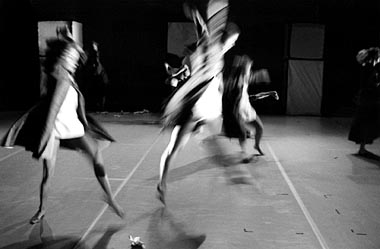Jan Kodet: Jade
Czech Republic
choreography and concept: Jan Kodet
dancers: Marika Blahoutová, Helena Arenbergerová, Jan Kodet, Martin Vraný, Michal Záhora
lighting design: Dan Tesař
music: mixed music
costumes: Jan Kodet
production: ConcordiaDance
Jan Kodet started to work on this choreography after a strong emotional experience - initiation into the Japanese healing energy "Reiki".
Jan Kodet: Danse Macabre
Czech Republic
choreography: Jan Kodet
dancers: Helena Arenbergerová, Leona Qaša Kvasnicová, Tereza Indráková, Veronika Knytlová, Lenka Vágnerová, Michal Záhora, Petr Opavský
lighting design: Dan Tesař
music: Ivan Acher
stage design, costumes: Kristýna Täubelová
production: Archa Theatre
Foto (c) Jiří Volek.
Choreographer Jan Kodet has created in Danse Macabre a dance without attributes, spontaneous, physical, beautiful (bel canto), performed at a high standard (dell'arte), with a simple deliberateness, intellectualism, deconstruction. He does not bang the drum of exaggerated theatricality with the theme of the plague, it is a gentle allusion, expressed in flickering statuesque moments or quick, unwitting glances of old woodcut images, "once upon a time". The existential theme is represented by an unrestrained wave of dance. The "contagion" of the plague is most obvious in the lighting, which feverishly colours the evolution of the dance. Changes in the the lighting (that "invisible dancer") are unusually musical yet remain suited to the dance. One such lighting cue, focusing on the table upstage, the table which might also be an altar or the pedestal of a Baroque statue, a dancer appears spinning a light coloured piece of material around her body in a sort of spiral, while our attention is drawn to other dancers on moving, suspended blocks, positioned into hierarchical places. How could we, the inhabitants of Prague, not be reminded of the plague column sculptures which popped up everywhere here during the Baroque era epidemics?
The chronicle of the plague is written before us in light on the dance floor. A sentence of projected text slides across the floor right under our eyes, slipping under the legs of the dancers, touching some of them and not others. We are reminded that when we dance in Central Europe, it is always on the graves of those who came before us.
Jade, named after the green, semi-precious stone from which Chinese figurines and decorative boxes are made, presents the audience with a riddle. Just who are these mysterious, self-replicating, ever-changing dancers, emerging from the darkness only to slip back into it, expressing themselves in indecipherable relationship-puzzles? Are they mere jade chess pieces, being played out by the choreographer's imagination, or is this an allegory to a recently experienced love story? Jade is a stone typically used for souvenirs, for memories. So what do you think?
Jan Kodet - he gained his first dancing experience at the University Art Company of the Charles University. In 1991 he graduated at the Academy of Musical Arts where he studied dance and dancing pedagogy under Ivanka Kubicova. In 1992-93 he was a member of the Dance Berlin, in 1993-96 a member of the Frankfurt S.O.A.P. Dance Theatre of the Portugal choreographer Rui Horta and in 1996-97 a member of the Ballet Gulbenkian Lisabon. At the moment he works as an assistant of Rui Horta. Mainly abroad he teaches techniques of modern dance, composition and improvisation. As a choreographer he works most of all in the Czech Republic. His most important works include the projects No End (1998) and Gates (2000).

